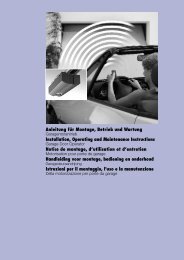2 - Hormann
2 - Hormann
2 - Hormann
You also want an ePaper? Increase the reach of your titles
YUMPU automatically turns print PDFs into web optimized ePapers that Google loves.
ENGLISH<br />
OPEN end-of-travel position<br />
Move to the desired OPEN end-of-travel position using<br />
the impulse function in dead man operation and circuit<br />
board button T. Press button P to confirm this position.<br />
The green LED will signal that the end-of-travel position<br />
is detected by quickly flashing.<br />
Double-leaf gate system<br />
With a double-leaf gate system, DIL switch 3 (function:<br />
leaf selection) must be ON and the steps in Chapter<br />
4.4.2 repeated for leaf B (see Figure 6b.2 ).<br />
Note<br />
During the learning process, the end-of-travel positions are<br />
partially or fully detected by a force cut-off activation. The<br />
learning force must be large enough so the force cut-off is<br />
not unintentionally triggered. Increase the learning force if<br />
the force cut-off is unintentionally triggered during the<br />
learning cycle or if the end-of-travel positions are not reached<br />
(see Chapter 4.5.1).<br />
4.4.3 Completion of set-up mode<br />
After completion of the set-up mode, set DIL switch 4<br />
(function: learning the gate travel) to OFF. The green<br />
LED signals that forces must be learned by flashing<br />
quickly (see Figure 6a.2/6b.2 ).<br />
Note<br />
The safety devices are activated.<br />
4.5 Learning the forces<br />
Once the end-of-travel positions have been learned or<br />
specific changes made, the forces must be learned. For<br />
this, three successive gate cycles must take place,<br />
throughout which none of the safety devices may be<br />
triggered. Recording the forces takes place automatically<br />
by press-and-release (maintained function) in both<br />
directions, i.e. once an impulse has been given, the<br />
operator causes the gate to travel to the end-of-travel<br />
position. The green LED flashes throughout. This LED is<br />
steadily illuminated once the force learning cycles have<br />
been completed.<br />
Learning the forces for the OPEN end-of-travel<br />
position:<br />
Press circuit board button T once, the operator automatically<br />
moves into the OPEN end-of-travel position.<br />
Learning the forces for the CLOSE end-of-travel<br />
position:<br />
Press circuit board button T once, the operator automatically<br />
moves into the CLOSE end-of-travel position.<br />
This procedure must be repeated twice.<br />
08.2007 TR10A028-A RE<br />
CAUTION<br />
Due to special installation situations, it can,<br />
however, happen that the previously learned<br />
forces prove inadequate which can lead to<br />
unjustified reversing. Readjust the forces in such<br />
cases. The force should not be set too high, as<br />
this can cause injury to persons and/or damage<br />
to the gate.<br />
4.5.1 Changing the learned forces<br />
A potentiometer is available to set the force limits of the<br />
gate when opening and closing; it is identified with Kraft<br />
F (Force F) on the control circuit board. The increase in<br />
the force limit is a percentage increase in relation to the<br />
learned values, where the setting of the potentiometer<br />
denotes the following force increase (see Figure 6.1 ):<br />
Full left + 0 % force<br />
Centred + 15 % force<br />
Full right + 75 % force<br />
CAUTION<br />
The learned force setting must be checked using<br />
a suitable force measuring device to make sure<br />
that the values are permissible within the<br />
application scope of European Standards<br />
EN 12453 and EN 12445 or the corresponding<br />
national regulations.<br />
4.5.2 Creep speed<br />
If the potentiometer setting is at 0% and the force<br />
measured by the force measuring device is still too high,<br />
it can be changed via a reduced travel speed.<br />
• DIL switch 4 at ON<br />
• After approx. 3 seconds, if the green LED is flashing,<br />
set DIL switch 12 to ON (function: moderate speed)<br />
• DIL switch 4 at OFF<br />
• DIL switch 12 at OFF<br />
• Three consecutive force learning cycles must then be<br />
performed (see Chapter 4.5)<br />
•Recheck with the force measuring device<br />
4.6 Size of the leaf offset<br />
To avoid collisions in double-leaf systems during gate<br />
travel, a large leaf offset is useful for asymmetric gates<br />
with thresholds, whereas a smaller leaf offset is sufficient<br />
for symmetric gates with thresholds, (DIL switch 2 at<br />
OFF!)<br />
DIL switch 3: Leaf selection/large leaf offset<br />
(see Figure 6.2 )<br />
Function Size of leaf offset:<br />
ON Small leaf offset<br />
OFF Large leaf offset<br />
4.7 Reversing limit<br />
During operation with mechanical limit stops, the gate<br />
must differentiate between two options: whether the leaf<br />
contacts the limit stop (leaf stops) or an obstruction (leaf<br />
reverses direction). The limit range can be changed as<br />
follows (see Figure 6.3 and Chapter 3.1.3). To adjust, set<br />
DIL switch 12 to ON. Select the appropriate leaf with DIL<br />
switch 3. Pay attention that the selected leaf is able to<br />
move freely in a double-leaf system, depending on the<br />
threshold.<br />
The reversing limit can now be set step-by-step. The<br />
reversing limit is reduced by briefly pressing circuit board<br />
button P and increased by briefly pressing circuit board T.<br />
During the procedure to learn the reversing limits, the<br />
red LED displays the following settings: ➤<br />
57












